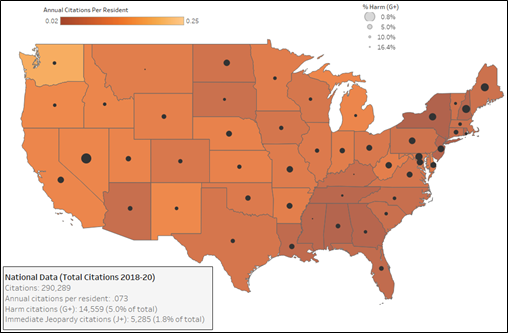NY ranks last in citation rates despite widespread substandard care and neglect.
Fundamentally, a state’s oversight of nursing home care boils down to two components: (1) its ability to identify and cite a facility when a failure to meet standards (i.e., a deficiency) exists and (2) its ability to appropriately rate the deficiencies it finds in terms of their “scope and severity.”
In a new report, LTCCC finds that New York is failing to meet its oversight requirements and to ensure that its residents are safe and treated with dignity. New York consistently ranks at or near the bottom of most enforcement metrics evaluated in this report including Overall Citations, Antipsychotic Drugging, Infection Control, and Sufficient Staffing.
Note: Enforcement performance was measured based on citation rates (how often were nursing homes cited, adjusted per resident) and citation severity (how often were citations categorized as harm (G+)) for surveys (inspections) over the most recent three-year period (2018-20). LTCCC assessed 52 U.S. states/territories including D.C. and Puerto Rico.
Key Findings
- New York ranked at the bottom of most enforcement metrics evaluated in this report, meaning the state showed lower rates of citations and lower proportions of citations categorized as “Harm” or “Immediate Jeopardy.” The identification of resident harm is critical since facilities rarely face any penalty for citations that are identified as “no harm.”
- New York ranks last in overall citations per resident with surveyors substantiating one violation for every 50 residents annually in the three-year period from 2018 to 2020. Nationwide, the annual citation rate (.07) was nearly four-times that of New York’s (.02).
- One in 50 (2.0%) of the state’s citations were cited as harm (rank 48 of 52) and one in every 230 (0.4%) were cited as Immediate Jeopardy (J or above), ranking 49th.

- Federal data indicate that, nationwide, there are an average of just eight (8.1) inappropriate drugging (AP) citations per year for every 1,000 residents reported to be receiving antipsychotics (RAP Rate). New York’s RAP Rate (3.9), which ranks 43rd, is less than half of the national average. The state reported 200 total AP citations during the three-year period.
- Though antipsychotic drugs have a “black-box warning” for elderly people, due to serious and potentially lethal side-effects, New York never categorized inappropriate drugging as causing harm during the three-year period. (MDS reports from Q4 2019 indicate that 17.16% of New York’s nursing home residents are receiving antipsychotics).
- New York ranked last (52nd) in annual Infection Control & Prevention (F880) citation rates (1.6 per 1,000 residents); these citations were categorized as harm only 1.6% of the time (making it extremely unlikely that the facility would face any penalty for substandard infection control practices).
- New York rarely cited nursing homes for Sufficient Staffing (F725) despite rampant understaffing in the state. A total of 55 SS citations were reported in the three-year period, or 0.18 citations annually for every 1,000 residents (ranked 46th).
- Pressure ulcers are a problem for nearly 9,000 nursing home residents in New York. However, New York nursing homes were only cited the equivalent of 0.4% of the time that a resident has a pressure ulcer (ranked 44th). Though pressure ulcers are, by definition, a wound, New York surveyors only identified substandard pressure ulcer care as harmful to a resident 14% of the time (15 of the 112 Pressure Ulcer citations (F686)).
For the full report, including more enforcement data on New York and other states, visit nursinghome411.org/survey-data-report.
